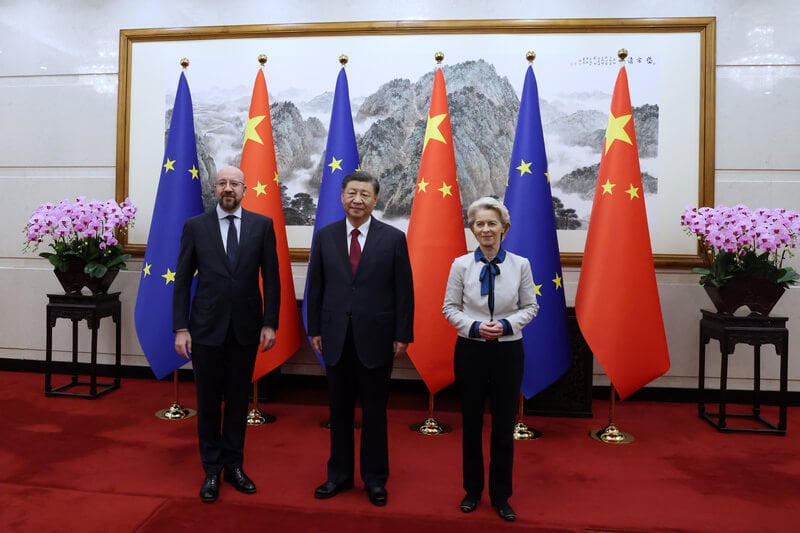The European Union and Central Asian countries often exchange messages of affection regarding joint projects that would increase the capacities and significance of the Middle Corridor as the transport artery between China and Europe.
Last January, the European Commission announced its readiness to collect €10 billion, with partners and investors, as an investment in sustainable transport connectivity in Central Asia.
The government of Kazakhstan, as a country with a central position in the project, immediately responded positively and offered its 2 ports on the Caspian Sea and all the remaining 22 national airports at the disposal of European investors.
The investment rapprochement of the EU and the region of Central Asia is gaining momentum and significance as one of the possible responses to the disruptions caused by major crises - Russia's aggression against Ukraine and attacks by the pro-Iranian Houthis on commercial ships in the Red Sea.
Since Russia invaded Ukraine a little more than 2 years ago, transport between East and West Eurasia via Russian territory and the so-called Northern Corridor has almost stopped.
Even though this direction was used more for transporting goods between China and Europe, the sanctions against Russia made it necessary to start searching for long-term alternatives.
A tempting alternative
Given the uncertainty about when and to what degree it could be utilised again, the Trans-Caspian Transport Corridor, also known as the Middle Corridor, emerged as the primary choice for bypassing the route through Russia.
At the same time, the search for an alternative for transport between China and Europe requires a rapid solution due to the crisis in the Red Sea.
In these calculations, the numerous advantages of the Central Asian corridor come to the fore. It is significantly shorter than the land route through Russia and shorter than the sea route, which is now even longer due to bypassing the Red Sea and the Suez Canal.
Compared to the Northern Corridor, the route from China through Central Asia and the Caucasus states is shorter by about 2,000 to 3,000 kilometres
Compared to the Northern Corridor, the route from China through Central Asia and the Caucasus states is shorter by about 2,000 to 3,000 kilometres, thus shortening transport by 5 to 10 days.
The advantages over sea shipping are considerably higher, reducing transit time by up to 15 days. Using the Middle Corridor is more favourable due to better climatic conditions than via Russia and its further connection with the Middle East, North Africa and Mediterranean destinations via ports in Turkey.
Achieving the goals of Global Gateway
The traffic along this corridor has been experiencing significant growth, even though the bulk of the transport of goods between the East and the West still follows traditional routes. Last February, about 150% more products were transported via this corridor than in the same month in 2023.
Increasing the capacity of the Middle Corridor is of interest to everyone on it, including China and the EU as its endpoints.
The latest announcements about investment in the infrastructure of 5 Central Asian countries hint at a much greater presence of European capital in the region and coincide with the goals of its Global Gateway project.
The corridor has been burdened with bottlenecks that require significant investments to become more flowable
The Global Gateway, designed as a competitor and counterweight to China's Belt and Road initiative, wants to decrease its influence, notably in the Central Asian region, and therefore, investments in the Middle Corridor are more than appealing to the EU's strategic ambitions.
The expectations are fraught with difficulties and risks and continue to increase the caution of European governments and investors.
The corridor has been burdened with bottlenecks that require significant investments to become more flowable, and this particularly applies to the port capacities of Kazakhstan and Azerbaijan on the Caspian Sea.
How to avoid political risks?
The political risks are even greater given the traditional instability in the region and the complex map of interests of its states, which often conflict.
The benefit the EU sees in developing the Middle Corridor includes political stabilisation in the region, following significant investments and a stronger connection of local governments through unifying regulations.
However, the strengthening of the Middle Corridor carries the risk of the European project indirectly breathing air into the weakened Chinese competitor, the Belt and Road project, in a region where China has been intensively increasing its influence and asserting itself as the principal alternative partner to Russian influence, which has been declining due to aggression against Ukraine.
 The strengthening of the Middle Corridor carries the risk of the European project indirectly breathing air into the weakened Chinese competitor, the Belt and Road project
The strengthening of the Middle Corridor carries the risk of the European project indirectly breathing air into the weakened Chinese competitor, the Belt and Road project
Also, increasing the capacity of the Middle Corridor would also suit the countries that the EU sees as sources of destabilisation, primarily Iran and Russia. The EU's investments in the transport infrastructure of Central Asia also represent the risk of helping the economies against which there is a sanction regime.
In a study from last November, the World Bank gave significant advantages to developing the Middle Corridor, estimating that by 2030, it could halve the time it takes to transport goods between China's western border and Europe. By the end of this decade, the transport volume along this corridor is expected to triple.
The recently expressed readiness of the EU to be central to collecting billions of euros for investing in infrastructure in Central Asia to increase the capacity of the Middle Corridor might represent a cautious entry into the development of this project.
However, there are significant political risks from indirectly supporting the regimes that the EU wants to bypass, and they still outweigh all the benefits of developing the Middle Corridor.